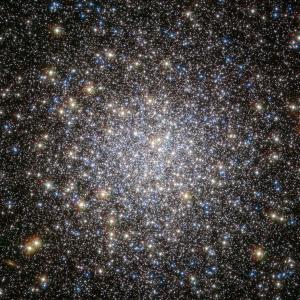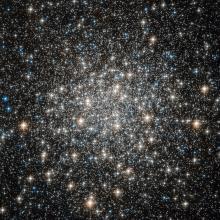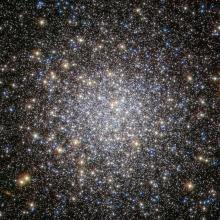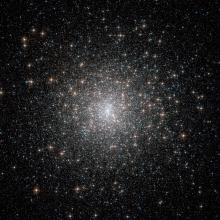This Hubble Space Telescope image shows the core of Messier 5, a globular star cluster about 25,000 light-years away in Serpens, the snake. The cluster contains hundreds of thousands of stars all packed into a spherical region about 165 light-years across. The cluster formed about 13 billion years ago, when the universe was less than one billion years old, making it one of the oldest members of the Milky Way Galaxy. [ESA Hubble/NASA]
You are here
Messier 5
The star cluster Messier 5 is big, old, and crowded. It contains hundreds of thousands of stars, all packed into a ball that’s about 165 light-years across. By comparison, a similar volume of space in our region of the galaxy would hold only a few thousand stars.
The cluster is ancient — it formed as early as 13 billion years ago — less than one billion years after the birth of the universe. That makes it one of the oldest components of the Milky Way.
But the stars of Messier 5 may not all be that old.
A recent study found the stars might have been born in waves. The first wave gave birth to massive stars — many times heavier than the Sun. They burned out in a hurry, though, and exploded. Shockwaves from the explosions might have helped trigger the second wave — huge numbers of smaller stars born in the central region of the cluster. And the third wave came later still, with many more stars born outside the center.
Whenever they were born, the stars form an impressive group. Messier 5 is about 25,000 light-years away, in Serpens Caput — the head of the snake. It’s in the southeast as the sky gets fully dark. It’s too faint to see with the eye alone. But binoculars reveal a smudge of light that looks like a fuzzy star. And long-exposure images show thousands of individual stars — some of the oldest residents of the Milky Way.
We’ll talk about another cluster in Serpens tomorrow.
Script by Damond Benningfield
Get Premium Audio
Listen to today's episode of StarDate on the web the same day it airs in high-quality streaming audio without any extra ads or announcements. Choose a $8 one-month pass, or listen every day for a year for just $30.







